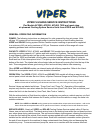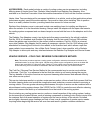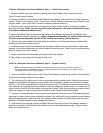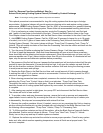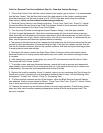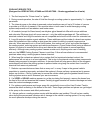COOLANT SERVICE TIPS
(Designed for VIPER AF3250, AF3400 and SOLAR 7500 – Good suggestions for all units)
1. The fluid required for “Primer Level” is 1 gallon.
2. During normal operation, the rate of fluid flow through a cooling system is approximately 3 – 4 quarts
per minute.
3. The internal pump on the shop air powered coolant machines can pull up to 20 inches of vacuum
or provide up to 40 psi of pressure. Care must be taken in both cases to avoid damaging cooling
system components such as radiators and heater cores.
4. All coolants (except for Sierra brand) are ethylene glycol based but differ with unique additives
and colorants. Ethylene glycol will never wear out – only the additives package will. The additives in
standard coolants and long-life coolants are not compatible and should not be mixed for extended use.
5. Long-life coolants contain organic additives. These additives coat the inside of a brand new system
when first installed and this coating is what gives the coolant its ability to provide longer service
intervals. When exposed to air in a low fluid situation, this coating can “grow” and cause blockage in
the cooling system, reducing system and vehicle performance. A good coolant flush (using a chemical
cleaner) is required to remove this build-up and restore the cooling system to normal operating
efficiency. Although many cooling system cleaners contain acid, requiring extra care in handling
and use, the VIPER Cooling System Cleaner is acid-free. Follow all manufacturer’s recommended
practices when using a cooling system cleaner chemical.
6. When long-life coolants are placed into a system that first contained standard coolant, the
performance will not act as in a new installation. This is due to the internal cooling system components
already being exposed to inorganic additives. A chemical flush will help remove some of the inorganic
contaminants and allow the cooling system to perform better using long life coolant than it would if a
chemical flush were not performed.
7. Radiator cap manufacturers claims that as many as 1 in every 5 caps in the general vehicle
population is operating improperly and should be replaced. Always perform a pressure test to ensure
proper cap function – this is a great way to ensure the vehicle owner gets the greatest benefit from a
cooling system service and it increases your service revenue.
8. If a VIPER or SOLAR machine appears to not be circulating fluid properly, remove the hoses from
the front of the unit and examine the screens. Partially plugged screens will create a blockage and slow
down the coolant exchange process.
9. For optimum performance and longer pump life, periodically rinse out the Used Coolant Tank to
remove the debris collecting in the bottom of the tank. These larger particles and pieces can get lodged
in the pump or the screens and affect performance.
10. Always perform a cooling system service with the radiator cap installed. This will act as a safety
valve during the process and minimize risk of damage to the vehicle’s cooling system if, for any reason,
too much pressure develops during the service.



